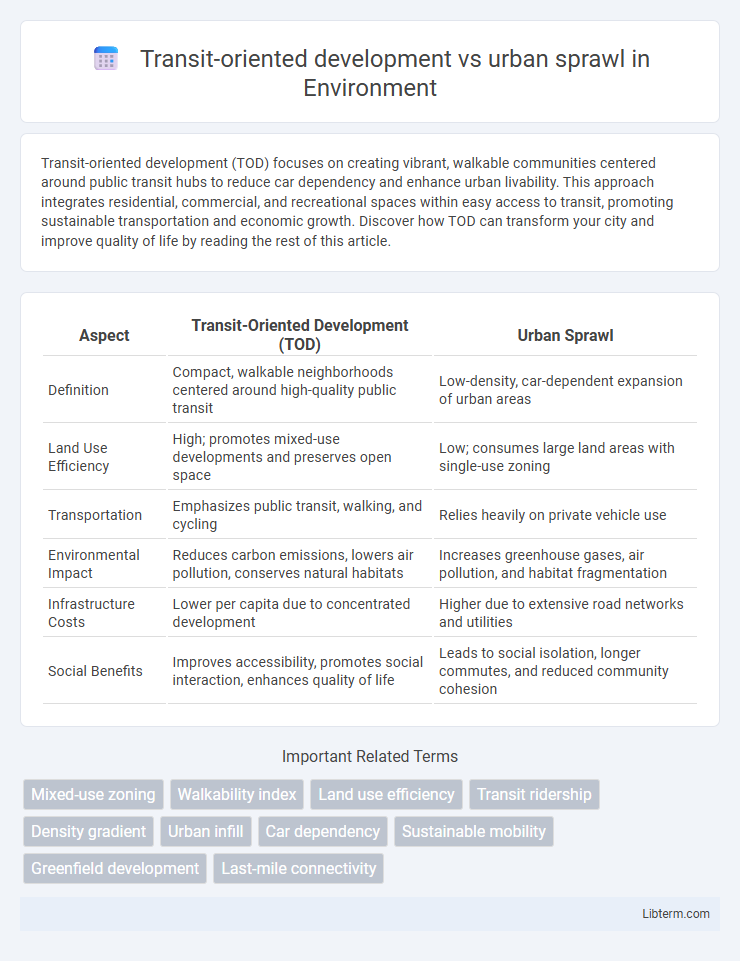Transit-oriented development (TOD) focuses on creating vibrant, walkable communities centered around public transit hubs to reduce car dependency and enhance urban livability. This approach integrates residential, commercial, and recreational spaces within easy access to transit, promoting sustainable transportation and economic growth. Discover how TOD can transform your city and improve quality of life by reading the rest of this article.
Table of Comparison
| Aspect | Transit-Oriented Development (TOD) | Urban Sprawl |
|---|---|---|
| Definition | Compact, walkable neighborhoods centered around high-quality public transit | Low-density, car-dependent expansion of urban areas |
| Land Use Efficiency | High; promotes mixed-use developments and preserves open space | Low; consumes large land areas with single-use zoning |
| Transportation | Emphasizes public transit, walking, and cycling | Relies heavily on private vehicle use |
| Environmental Impact | Reduces carbon emissions, lowers air pollution, conserves natural habitats | Increases greenhouse gases, air pollution, and habitat fragmentation |
| Infrastructure Costs | Lower per capita due to concentrated development | Higher due to extensive road networks and utilities |
| Social Benefits | Improves accessibility, promotes social interaction, enhances quality of life | Leads to social isolation, longer commutes, and reduced community cohesion |
Introduction to Transit-Oriented Development and Urban Sprawl
Transit-oriented development (TOD) emphasizes creating compact, walkable communities centered around high-quality public transit systems to reduce dependence on cars and encourage sustainable urban growth. Urban sprawl describes a pattern of low-density, car-dependent expansion on city outskirts, leading to increased traffic congestion, environmental degradation, and inefficient land use. TOD promotes efficient land use and environmental benefits by concentrating housing, jobs, and services near transit hubs, contrasting sharply with the dispersed nature of suburban sprawl.
Key Concepts: Defining TOD and Urban Sprawl
Transit-oriented development (TOD) emphasizes high-density, mixed-use neighborhoods centered around public transit hubs to reduce car dependency and promote walkability. Urban sprawl describes the low-density, car-dependent expansion of cities characterized by scattered residential and commercial areas with limited public transit access. Key concepts of TOD include compact design, accessibility, and sustainable growth, whereas urban sprawl often leads to increased traffic congestion, environmental degradation, and inefficient land use.
Historical Evolution of Urban Growth Patterns
Transit-oriented development (TOD) emerged as a response to the negative impacts of urban sprawl, characterized by low-density, automobile-dependent expansion that dominated 20th-century city growth. Historical urban growth patterns reveal a shift from compact, walkable neighborhoods supported by streetcars and trains in the late 19th and early 20th centuries to sprawling suburbs facilitated by widespread automobile use post-World War II. The resurgence of TOD in recent decades promotes sustainable, mixed-use communities centered around public transit, aiming to counteract the inefficiencies and environmental challenges of sprawl.
Land Use and Urban Density Comparison
Transit-oriented development (TOD) prioritizes high-density, mixed-use land use patterns concentrated around public transit hubs, promoting efficient land utilization and reducing reliance on automobiles. Urban sprawl features low-density, single-use zoning that spreads development over large areas, leading to fragmented land use and increased infrastructure costs. TOD enhances walkability and reduces ecological footprints by concentrating urban density, whereas urban sprawl contributes to habitat fragmentation and greater vehicle emissions due to dispersed land use.
Transportation Infrastructure and Accessibility
Transit-oriented development (TOD) concentrates on creating high-density, mixed-use communities centered around efficient public transportation hubs, enhancing accessibility and reducing reliance on private vehicles. In contrast, urban sprawl is characterized by low-density, car-dependent expansion that stretches transportation infrastructure thinly over large areas, resulting in longer commutes and increased traffic congestion. TOD promotes sustainable mobility by integrating walkable neighborhoods with transit options, whereas urban sprawl often leads to fragmented infrastructure and limited accessibility to essential services.
Environmental Impacts: Sustainability vs. Ecological Strain
Transit-oriented development (TOD) reduces ecological strain by promoting higher-density, walkable communities centered around public transportation, which significantly lowers greenhouse gas emissions and energy consumption compared to urban sprawl. Urban sprawl increases reliance on automobiles, leading to habitat fragmentation, increased air pollution, and greater land consumption, which negatively impacts biodiversity and local ecosystems. Sustainability in TOD supports resource efficiency and minimizes carbon footprints, making it a critical strategy for mitigating climate change and preserving environmental health.
Economic Implications and Property Values
Transit-oriented development (TOD) boosts economic growth by concentrating investments around public transit hubs, increasing accessibility and attracting businesses, which raises local property values. Urban sprawl often leads to higher infrastructure costs, inefficient land use, and diminished accessibility, resulting in slower economic growth and more volatile property markets. TOD encourages higher-density, mixed-use neighborhoods that sustain long-term property value appreciation, while sprawl can cause fragmented development and lower overall real estate demand.
Community Health and Social Connectivity
Transit-oriented development (TOD) promotes walkable neighborhoods with mixed-use spaces that enhance community health by encouraging physical activity and reducing air pollution from vehicle emissions. In contrast, urban sprawl leads to car-dependent lifestyles, increasing sedentary behavior and diminishing social connectivity due to dispersed housing and limited public spaces. Studies show TOD fosters stronger social networks and improved mental well-being through accessible transit and communal areas, while urban sprawl correlates with higher rates of obesity and social isolation.
Case Studies: Successful TOD vs. Challenges of Sprawl
Transit-oriented development (TOD) exemplified by Vancouver's Canada Line integration highlights reduced car dependency, increased walkability, and efficient land use, driving sustainable urban growth. In contrast, Atlanta's sprawling metropolitan area illustrates challenges such as traffic congestion, high infrastructure costs, and environmental degradation due to low-density, car-centric expansion. These case studies underscore TOD's role in promoting compact, mixed-use communities while revealing urban sprawl's strain on resources and quality of life.
Future Trends and Policy Recommendations
Transit-oriented development (TOD) emphasizes compact, walkable communities centered around high-quality public transit, reducing car dependency and promoting sustainable urban growth. Future trends highlight increased investment in integrated multimodal transit systems and smart city technologies to enhance connectivity and livability. Policy recommendations include prioritizing zoning reforms that support mixed-use development near transit hubs, incentivizing affordable housing, and implementing measures to curb urban sprawl through greenbelt preservation and improved public transportation infrastructure.
Transit-oriented development Infographic

 libterm.com
libterm.com